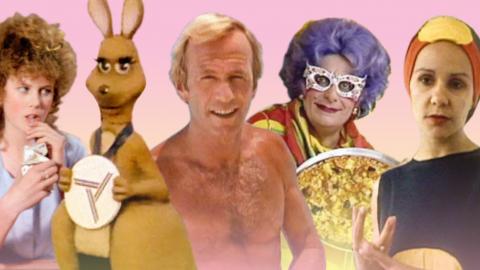

Digging into the archives for Crocodile Dundee: Part 1
This is the first in a two-part series about items from the NFSA collection relating to Crocodile Dundee (Peter Faiman, 1986, Australia), which opened in Australian cinemas on 24 April 1986.
Paul Hogan’s iconic Mick Dundee was central to the film’s success. Paul Byrnes writes, ‘Mick Dundee is all things to all people – self-made man, tough guy, bush philosopher, romantic lead, old-fashioned knight, defender of women, tamer of wild animals, and wandering free spirit.’
Sue sees a crocodile
Rushes are raw footage from a day’s shooting where the same scene is often repeated from various angles. These silent rushes show close-ups of Mick Dundee taking New York journalist Sue Charlton (Linda Kozlowski) out on the river with Walter (John Meillon). This short scene appears in the film and plays with music and no dialogue.
Silent rushes from Crocodile Dundee, 1986. Courtesy Rimfire Films Limited. NFSA title: 1370672
Hoges charms potential investors
The film was financed by Hogan and his business partner John Cornell, as well as a large group of private investors that included most of the cast and crew. Below are excerpts from the prospectus selling the ‘adventure comedy set in the Northern Territory and New York City’ to potential investors.
Hogan was already well known as ‘Hoges’ in Australia for his television comedy persona, and was famous in the US for the ‘put another shrimp on the barbie’ tourism campaign which began in 1984. The prospectus cover shows him chewing on a piece of wheat. It’s interesting to note how different the Mick Dundee costume and make-up was for the final shoot, compared with this picture.
Click images to enlarge

The front page of the Crocodile Dundee prospectus. NFSA title 447821

The film synopsis from the Crocodile Dundee prospectus. NFSA title 447821

Details of production from the Crocodile Dundee prospectus. NFSA title 447821
‘That’s not a knife…’
The film’s most famous joke ‘That’s not a knife…’ relies on the impressive bowie knife created by film armourer John Bowring. In this oral history excerpt Bowring tells the story behind the making of the knife.
All about sound
Sound recordist Gary Wilkins used this Nagra IV.2 Portable Sound Recorder (left) to record sound for Crocodile Dundee and Crocodile Dundee II (1988, Australia, John Cornell).
The NFSA collection also includes the Series III Fairlight CMI (Computer Musical Instrument) used by Peter Best to compose and arrange the soundtrack for the film.

Nagra 4.2 portable sound recorder. NFSA title: 528233
See Part Two for materials from the worldwide promotional campaign for the film.
The National Film and Sound Archive of Australia acknowledges Australia’s Aboriginal and Torres Strait Islander peoples as the Traditional Custodians of the land on which we work and live and gives respect to their Elders both past and present.


